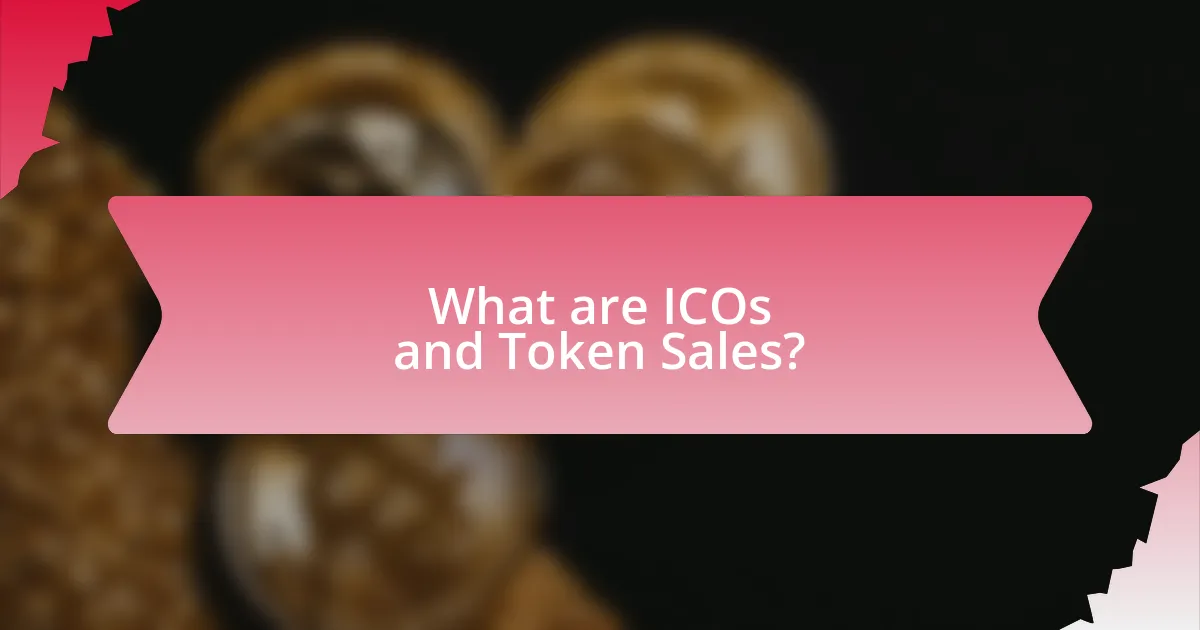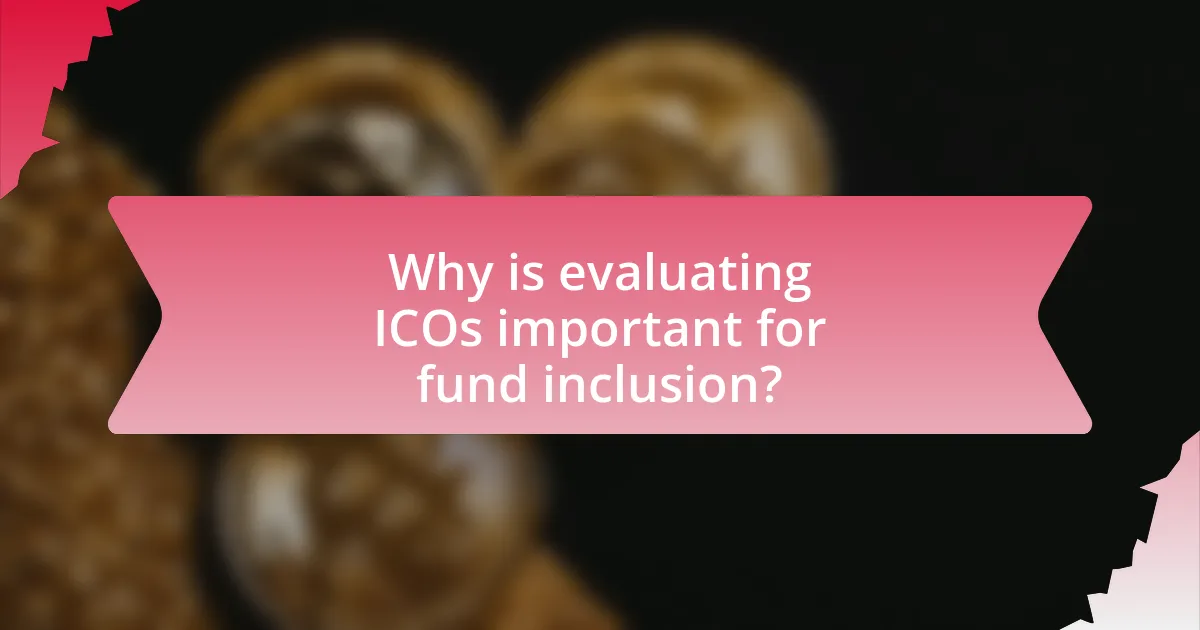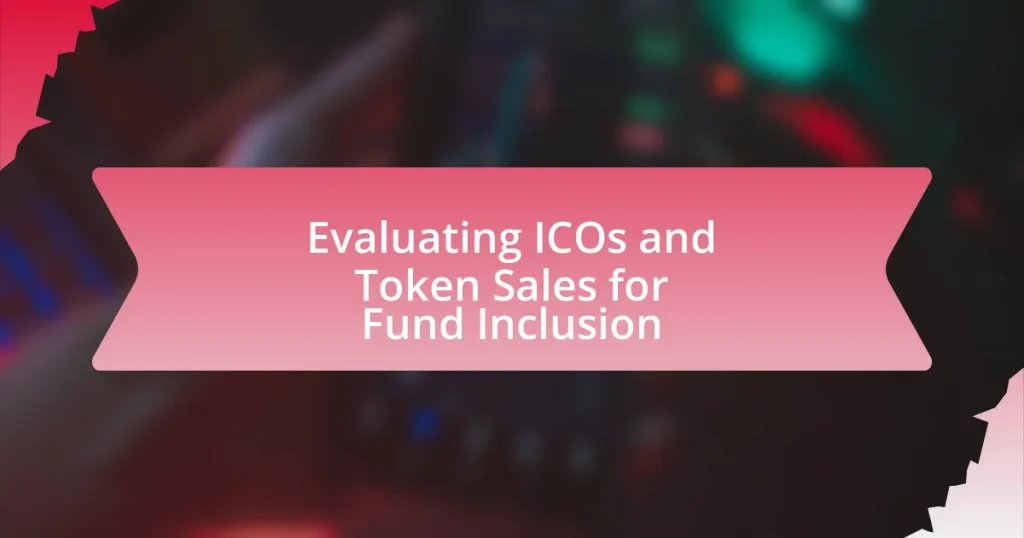Initial Coin Offerings (ICOs) and token sales are innovative fundraising mechanisms that allow new cryptocurrencies or tokens to be sold to investors, typically in exchange for established cryptocurrencies like Bitcoin or Ethereum. This article examines the differences between ICOs and traditional fundraising methods, highlighting their key characteristics, such as the use of blockchain technology and immediate liquidity for investors. It also discusses the types of tokens sold in ICOs, including utility and security tokens, and emphasizes the importance of evaluating ICOs for fund inclusion to mitigate risks associated with fraudulent schemes. Key evaluation criteria include the project’s whitepaper, team expertise, market demand, and regulatory compliance, which are essential for making informed investment decisions.

What are ICOs and Token Sales?
ICOs, or Initial Coin Offerings, are fundraising mechanisms in which new cryptocurrencies or tokens are sold to investors, typically in exchange for established cryptocurrencies like Bitcoin or Ethereum. Token sales, often synonymous with ICOs, involve the distribution of tokens to raise capital for a project, allowing investors to participate in the potential growth of the project. According to a report by CoinDesk, ICOs raised over $4 billion in 2017 alone, highlighting their significance in the cryptocurrency market.
How do ICOs differ from traditional fundraising methods?
ICOs, or Initial Coin Offerings, differ from traditional fundraising methods primarily in their use of blockchain technology and cryptocurrency for capital raising. Unlike traditional fundraising, which often relies on equity or debt financing through investors or banks, ICOs allow companies to issue tokens directly to the public in exchange for cryptocurrencies like Bitcoin or Ethereum. This method enables broader access to funding, as it can reach a global audience without the regulatory barriers typically associated with traditional fundraising. Furthermore, ICOs often provide immediate liquidity for investors, as tokens can be traded on various exchanges shortly after issuance, contrasting with the longer timelines and restrictions of traditional investment vehicles.
What are the key characteristics of ICOs?
Initial Coin Offerings (ICOs) are characterized by several key features: they are fundraising mechanisms that allow companies to raise capital by issuing tokens in exchange for cryptocurrencies, typically Bitcoin or Ethereum. ICOs often involve a whitepaper that outlines the project’s goals, technology, and tokenomics, providing potential investors with essential information. Additionally, ICOs are usually conducted on blockchain platforms, ensuring transparency and security in transactions. The regulatory environment surrounding ICOs varies by jurisdiction, impacting their legality and investor protections. According to a report by CoinDesk, over $4 billion was raised through ICOs in 2017 alone, highlighting their significance in the cryptocurrency landscape.
Why are token sales becoming popular in the fundraising landscape?
Token sales are becoming popular in the fundraising landscape due to their ability to democratize access to capital and streamline the fundraising process. Unlike traditional fundraising methods, token sales allow startups to raise funds from a global pool of investors, often with lower barriers to entry. This accessibility is evidenced by the significant increase in the number of Initial Coin Offerings (ICOs), which raised over $7 billion in 2017 alone, according to data from CoinDesk. Additionally, token sales provide immediate liquidity for investors through the trading of tokens on various exchanges, enhancing their appeal. The combination of global reach, lower costs, and liquidity options has made token sales an attractive alternative for both startups and investors.
What types of tokens are typically sold in ICOs?
In Initial Coin Offerings (ICOs), the types of tokens typically sold are utility tokens and security tokens. Utility tokens provide access to a product or service within a blockchain ecosystem, while security tokens represent ownership or investment in an asset, often subject to regulatory scrutiny. According to a report by PwC, 80% of ICOs launched in 2018 were utility tokens, highlighting their prevalence in the market.
What are utility tokens and how do they function?
Utility tokens are digital assets designed to provide users with access to a product or service within a specific ecosystem. They function by enabling holders to utilize the underlying platform’s features, often incentivizing participation and engagement. For example, in a blockchain-based application, utility tokens may be required to access certain functionalities, such as transaction processing or premium services. This model is prevalent in Initial Coin Offerings (ICOs), where projects issue utility tokens to raise funds while offering users a stake in the platform’s future utility. The demand for these tokens typically correlates with the platform’s growth and adoption, validating their role in the ecosystem.
What are security tokens and what regulations apply to them?
Security tokens are digital representations of ownership in an asset, typically backed by real-world assets such as equity, real estate, or other financial instruments. These tokens are subject to securities regulations, which vary by jurisdiction but generally require compliance with laws governing the issuance and trading of securities. In the United States, for example, the Securities and Exchange Commission (SEC) applies the Howey Test to determine if a token qualifies as a security, which mandates that the token must involve an investment of money in a common enterprise with the expectation of profits derived from the efforts of others. Compliance with these regulations often includes registration requirements, disclosure obligations, and adherence to anti-money laundering (AML) and know your customer (KYC) protocols.

Why is evaluating ICOs important for fund inclusion?
Evaluating ICOs is crucial for fund inclusion because it ensures that investors can identify viable projects and mitigate risks associated with fraudulent schemes. A thorough evaluation process assesses the project’s whitepaper, team credentials, market potential, and regulatory compliance, which are essential factors in determining the legitimacy and sustainability of an ICO. For instance, according to a report by the Blockchain Research Institute, over 80% of ICOs launched in 2017 were deemed scams, highlighting the necessity of rigorous evaluation to protect investors and promote responsible funding practices.
What criteria should be used to evaluate an ICO?
To evaluate an Initial Coin Offering (ICO), key criteria include the project’s whitepaper, team expertise, market demand, token utility, and regulatory compliance. The whitepaper should clearly outline the project’s goals, technology, and roadmap, providing transparency and insight into its viability. The team’s expertise is crucial; a strong team with relevant experience increases the likelihood of project success. Market demand can be assessed through community engagement and interest, indicating potential adoption. Token utility refers to the practical use of the token within the ecosystem, which should be well-defined to attract investors. Lastly, regulatory compliance ensures that the ICO adheres to legal standards, reducing the risk of future legal issues. These criteria collectively help investors make informed decisions about the potential success and legitimacy of an ICO.
How does the project team impact the evaluation process?
The project team significantly impacts the evaluation process by influencing the credibility and perceived viability of the ICO or token sale. A competent project team with relevant experience and a strong track record can enhance investor confidence, leading to a more favorable evaluation outcome. For instance, research indicates that projects led by teams with prior successful ventures tend to attract more investment and achieve higher valuations, as seen in the analysis by the Cambridge Centre for Alternative Finance, which highlights the correlation between team expertise and funding success in ICOs.
What role does the whitepaper play in assessing an ICO?
The whitepaper serves as a critical document in assessing an Initial Coin Offering (ICO) by providing detailed information about the project, its goals, technology, and tokenomics. It outlines the problem the project aims to solve, the proposed solution, and the roadmap for development, which helps potential investors evaluate the project’s viability and credibility. A well-structured whitepaper typically includes technical specifications, market analysis, and the team’s qualifications, allowing investors to make informed decisions. For instance, a study by the Cambridge Centre for Alternative Finance found that 90% of successful ICOs had comprehensive whitepapers, indicating their importance in attracting investment and establishing trust.
How can investors assess the potential risks of ICOs?
Investors can assess the potential risks of Initial Coin Offerings (ICOs) by conducting thorough due diligence on the project, its team, and the underlying technology. This includes evaluating the whitepaper for clarity and feasibility, researching the backgrounds of the founding team for relevant experience, and analyzing the project’s roadmap and milestones. According to a study by the University of Cambridge, 90% of ICOs fail, highlighting the importance of risk assessment. Additionally, investors should consider regulatory compliance, market demand for the token, and the overall market conditions, as these factors significantly influence the success and viability of an ICO.
What are common red flags to look for in an ICO?
Common red flags to look for in an ICO include a lack of transparency, unrealistic promises, and an anonymous team. Transparency is crucial; if the project does not provide clear information about its goals, technology, and financials, it raises concerns about its legitimacy. Unrealistic promises, such as guaranteed returns or overly ambitious timelines, often indicate a potential scam. Additionally, if the team behind the ICO is anonymous or has no verifiable track record in the industry, it suggests a higher risk of fraud. According to a study by the University of Cambridge, over 80% of ICOs launched in 2017 were found to be scams, highlighting the importance of vigilance in evaluating these projects.
How can market conditions affect the success of an ICO?
Market conditions significantly influence the success of an Initial Coin Offering (ICO) by affecting investor sentiment and capital availability. For instance, during bullish market conditions, increased investor confidence often leads to higher participation rates in ICOs, resulting in greater funding success. Conversely, in bearish markets, negative sentiment can deter potential investors, leading to lower funding levels and potentially unsuccessful ICOs. Historical data shows that ICOs launched during market downturns, such as the 2018 cryptocurrency market crash, often failed to meet their funding goals, highlighting the direct correlation between market conditions and ICO performance.

What are the best practices for participating in ICOs?
The best practices for participating in ICOs include conducting thorough research, assessing the project’s whitepaper, and evaluating the team behind the ICO. Researching the project involves analyzing its market potential, technology, and use case, which helps in understanding its viability. The whitepaper should provide clear information about the project’s goals, tokenomics, and roadmap, ensuring transparency and feasibility. Evaluating the team is crucial, as a strong, experienced team increases the likelihood of project success. According to a study by the Cambridge Centre for Alternative Finance, projects with well-defined teams and clear objectives tend to perform better in the long term.
How can investors conduct thorough due diligence before investing?
Investors can conduct thorough due diligence before investing by systematically analyzing the project’s whitepaper, team credentials, market potential, and legal compliance. A detailed examination of the whitepaper reveals the project’s objectives, technology, and tokenomics, which are crucial for understanding its viability. Evaluating the team involves assessing their experience and past successes in relevant fields, as a strong team often correlates with project success. Additionally, analyzing market potential includes researching competitors and market trends to gauge demand for the project. Legal compliance is essential to ensure the project adheres to regulations, which can mitigate risks associated with fraud or legal issues. According to a report by PwC, 86% of ICOs fail due to lack of due diligence, highlighting the importance of these steps in making informed investment decisions.
What tools and resources are available for ICO research?
Various tools and resources are available for ICO research, including platforms like CoinMarketCap, ICO Drops, and Token Metrics. CoinMarketCap provides comprehensive data on market capitalization, trading volume, and historical price charts for cryptocurrencies, which aids in assessing the viability of ICOs. ICO Drops offers a calendar of upcoming, ongoing, and completed ICOs, along with ratings and reviews, helping investors gauge potential opportunities. Token Metrics utilizes AI-driven analytics to evaluate token performance and project fundamentals, providing insights that are crucial for informed investment decisions. These resources collectively enhance the research process by offering critical data and analysis for evaluating ICOs and token sales.
How can investors verify the legitimacy of an ICO?
Investors can verify the legitimacy of an Initial Coin Offering (ICO) by conducting thorough due diligence on the project, including reviewing the whitepaper, assessing the team’s credentials, and checking for regulatory compliance. A well-structured whitepaper should clearly outline the project’s goals, technology, and tokenomics, providing transparency. Additionally, investors should research the backgrounds of the team members to ensure they have relevant experience and a history of successful projects. Regulatory compliance can be verified by checking if the ICO is registered with relevant authorities and adheres to local laws, which adds a layer of credibility. Furthermore, investors can look for community engagement and feedback on platforms like social media and forums, as a strong community presence often indicates a legitimate project.
What strategies can enhance the chances of successful fund inclusion?
To enhance the chances of successful fund inclusion, conducting thorough due diligence is essential. This involves analyzing the project’s whitepaper, team credentials, market potential, and technological feasibility. Research indicates that projects with transparent roadmaps and experienced teams are more likely to secure funding; for instance, a study by CoinDesk found that 70% of successful ICOs had a well-defined business model and a strong advisory board. Additionally, engaging with the community through social media and forums can build trust and credibility, further increasing the likelihood of fund inclusion.
How can networking and community engagement influence investment outcomes?
Networking and community engagement can significantly influence investment outcomes by fostering trust and collaboration among investors and project teams. Strong networks provide access to valuable information, resources, and potential partnerships, which can enhance the credibility of investment opportunities. For instance, a study by the Harvard Business Review found that startups with robust networks are 20% more likely to secure funding compared to those without. Additionally, community engagement can lead to increased investor confidence, as active participation often signals a project’s viability and commitment to its stakeholders. This dynamic can ultimately result in higher investment amounts and better long-term performance for projects in the ICO and token sale space.
What are the benefits of diversifying investments across multiple ICOs?
Diversifying investments across multiple ICOs reduces risk and enhances potential returns. By spreading investments, an investor mitigates the impact of a single ICO’s failure, as the performance of other ICOs can offset losses. Historical data shows that diversified portfolios tend to outperform concentrated investments, as evidenced by studies indicating that diversification can lower volatility and improve risk-adjusted returns. For instance, a report by the CFA Institute highlights that diversified portfolios can achieve better long-term performance compared to those heavily invested in a single asset.
What are the common pitfalls to avoid when investing in ICOs?
Common pitfalls to avoid when investing in ICOs include inadequate research, lack of regulatory compliance, and ignoring the project’s whitepaper. Investors often fail to conduct thorough due diligence on the team behind the ICO, which can lead to investing in projects with unqualified or fraudulent individuals. Regulatory compliance is crucial, as many ICOs operate in legal gray areas, potentially exposing investors to legal risks. Additionally, neglecting to read and understand the whitepaper can result in misunderstandings about the project’s goals, technology, and tokenomics, leading to poor investment decisions. According to a study by the University of Cambridge, over 80% of ICOs launched in 2017 were found to be scams or failed projects, highlighting the importance of avoiding these pitfalls.
How can emotional decision-making impact investment choices?
Emotional decision-making can significantly impact investment choices by leading investors to make irrational decisions based on feelings rather than objective analysis. For instance, fear of missing out (FOMO) can drive investors to buy into an ICO or token sale without proper due diligence, resulting in poor investment outcomes. Conversely, fear or anxiety during market downturns may cause investors to sell assets prematurely, locking in losses instead of allowing for potential recovery. Research by the Behavioral Finance Institute indicates that emotional biases can lead to a 20% decrease in investment performance when investors act on emotions rather than rational analysis.
What are the consequences of failing to understand tokenomics?
Failing to understand tokenomics can lead to significant financial losses and poor investment decisions. Investors may misjudge the value and utility of a token, resulting in purchasing assets that lack real-world application or sustainable demand. For instance, a lack of comprehension regarding token supply, distribution, and incentives can cause individuals to overlook critical factors that influence price volatility and market behavior. Historical examples, such as the collapse of projects like BitConnect, illustrate how ignorance of tokenomics can lead to catastrophic outcomes, as investors were drawn in by misleading promises without grasping the underlying economic principles.
What practical tips can guide investors in evaluating ICOs?
Investors can evaluate ICOs by conducting thorough research on the project’s whitepaper, team, and market potential. A well-structured whitepaper should clearly outline the project’s goals, technology, and tokenomics, providing transparency and feasibility. The credibility of the team is crucial; investors should assess their experience and past successes in the blockchain or relevant industries. Additionally, analyzing the market potential involves understanding the problem the project aims to solve and its competitive landscape. According to a study by the Cambridge Centre for Alternative Finance, 80% of ICOs fail due to lack of transparency and poor project execution, highlighting the importance of these evaluation criteria.















